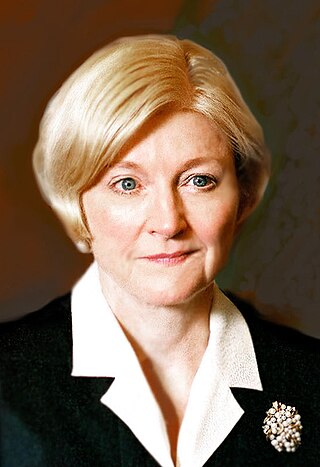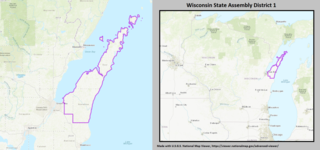Related Research Articles

Shirley Schlanger Abrahamson was the 25th chief justice of the Wisconsin Supreme Court. An American lawyer and jurist, she was appointed to the court in 1976 by Governor Patrick Lucey, becoming the first female justice to serve on Wisconsin's highest court. She became the court's first female chief justice on August 1, 1996, and served in that capacity until April 29, 2015. In all, she served on the court for 43 years (1976–2019), making her the longest-serving justice in the history of the Wisconsin Supreme Court.
Neil Patrick Crooks was an American lawyer. He was a justice of the Wisconsin Supreme Court from 1996 until his death in 2015. He was appointed as a county judge by a Democratic governor, later professing conservatism as a Supreme Court candidate in 1995 and 1996. In his later years, Crooks gained notice as a perceived judicial moderate and swing vote on a court otherwise divided into two ideological blocs.

Patience Drake "Pat" Roggensack is a retired American attorney and jurist. She was the 26th chief justice of the Wisconsin Supreme Court (2015–2021), and served 20 years on the high court, from 2003 through 2023.
Frederick P. Kessler is a retired American lawyer, arbitrator, judge, and Democratic Party politician. He served as a member of the Wisconsin State Assembly for 24 years between 1961 and 2019, and served 11 years as a state judge in the 1970s and 1980s.
Charles Joseph "Chuck" Chvala is an American real estate dealer, lawyer, and former politician. He served 20 years in the Wisconsin State Senate, representing Dane County, and was the Democratic leader from 1995 through 2002. His political career was ended by a 2002 scandal which found he and other lawmakers had illegally utilized state employees for campaign work.
Edward R. Brunner is an American lawyer and retired judge. He was a judge of the Wisconsin Court of Appeals from 2007 through 2011 in the Wausau-based District III. Previously, he was a Wisconsin Circuit Court Judge for 19 years, and was Chief Judge of the 10th District of Wisconsin Circuit Courts from 1999 through 2005.
Alan S. Robertson is an American lawyer, and retired Republican politician and judge. He was a member of the Wisconsin State Assembly for three terms, and was an appointed Wisconsin Circuit Court judge in Trempealeau County.

The 1st Assembly District of Wisconsin is one of 99 districts in the Wisconsin State Assembly. Located in northeastern Wisconsin, the district comprises all of Door and Kewaunee counties, as well as portions of northeast Brown County. The district is represented by Republican Joel Kitchens, since January 2015.

The 2nd Assembly District of Wisconsin is one of 99 districts in the Wisconsin State Assembly. Located in northeast Wisconsin, the district comprises most of northern Manitowoc County, including the city of Two Rivers, as well as most of the southern half of Brown County, including most of the city of De Pere. The district is represented by Republican Shae Sortwell, since January 2019.

The 3rd Assembly District of Wisconsin is one of 99 districts in the Wisconsin State Assembly. Located in northeast Wisconsin, the district comprises most of the north half of Calumet County, and parts of southeast Outagamie County and northwest Manitowoc County. It includes the city of Brillion and parts of the cities of Appleton and Menasha, as well as the villages of Combined Locks, Kimberly, Hilbert, Potter, and Sherwood. The district is represented by Republican Ron Tusler, since January 2017.

The 4th Assembly District of Wisconsin is one of 99 districts in the Wisconsin State Assembly. Located in northeast Wisconsin, the district comprises part of central Brown County, including the villages of Ashwaubenon and Allouez, and parts of the city of Green Bay and the village of Howard. The district also contains Lambeau Field and historic Allouez Catholic Cemetery and Woodlawn Cemetery. The district is represented by Republican David Steffen, since January 2015.

The 5th Assembly District of Wisconsin is one of 99 districts in the Wisconsin State Assembly. Located in northeast Wisconsin, the district comprises most of the eastern half of Outagamie County, including the city of Kaukauna, as well as the town of Hobart in western Brown County. The district also includes nearly all of the Oneida reservation spanning the two counties. The district is represented by Republican Joy Goeben, since January 2023. The 5th Assembly district is located within Wisconsin's 2nd Senate district, along with the 4th and 6th Assembly districts.

The 12th Assembly District of Wisconsin is one of 99 districts in the Wisconsin State Assembly. Located in southeast Wisconsin, the district is entirely contained within northwest Milwaukee County. It comprises much of the north side of the city of Milwaukee, as well as part of northern Wauwatosa. The district is represented by Democrat LaKeshia Myers, since January 2019.

The 14th Assembly District of Wisconsin is one of 99 districts in the Wisconsin State Assembly. Located in southeast Wisconsin, the district comprises parts of western Milwaukee County. It includes most of the city of Wauwatosa and about half of West Allis. The district is represented by Democrat Robyn Vining, since January 2019.

The 18th Assembly District of Wisconsin is one of 99 districts in the Wisconsin State Assembly. Located in southeast Wisconsin, the district is entirely contained within the boundaries of the city of Milwaukee in central Milwaukee County. It comprises neighborhoods of Milwaukee's west side, including Washington Heights and Sherman Park. It includes landmarks such as the Miller Brewing Company and Washington Park. The district is represented by Democrat Evan Goyke, since January 2013.

Redistricting in Wisconsin is the process by which boundaries are redrawn for municipal wards, Wisconsin State Assembly districts, Wisconsin State Senate districts, and Wisconsin's congressional districts. Redistricting occurs—as in other U.S. states—once every decade, usually in the year after the decennial United States census. According to the Wisconsin Constitution, redistricting in Wisconsin follows the regular legislative process, it must be passed by both houses of the Wisconsin Legislature and signed by the Governor of Wisconsin—unless the Legislature has sufficient votes to override a gubernatorial veto. Due to political gridlock, however, it has become common for Wisconsin redistricting to be conducted by courts. The 1982, 1992, and 2002 legislative maps were each created by panels of United States federal judges.

The 33rd Assembly District of Wisconsin is one of 99 districts in the Wisconsin State Assembly. Located in southeast Wisconsin, the district comprises the southern half of Jefferson County and parts of northeast Rock County. It includes the cities of Fort Atkinson, Jefferson, and Milton, along with the norrthern half of the city of Whitewater and part of the city of Janesville, as well as the villages of Palmyra and Sullivan. The district is represented by Republican Scott Johnson, since January 2023.

The 47th Assembly District of Wisconsin is one of 99 districts in the Wisconsin State Assembly. Located in south-central Wisconsin, the district comprises municipalities in south-central Dane County, including the city of Monona, the village of McFarland, and the northern half of the city of Fitchburg. It also contains the Capital Springs State Recreation Area, the Pflaum-McWilliams Mound Group, and the Alliant Energy Center. The seat is represented by Democrat Jimmy P. Anderson since January 2017.

The 68th Assembly District of Wisconsin is one of 99 districts in the Wisconsin State Assembly. Located in Northwestern Wisconsin, the district comprises the eastern half of Eau Claire County and about half of Clark County, as well as part of southeast Chippewa County. The district includes the cities of Altoona, Augusta, Greenwood, Osseo, Owen, Stanley, and Thorp. The district is represented by Republican Karen Hurd, since January 2023.

The 85th Assembly District of Wisconsin is one of 99 districts in the Wisconsin State Assembly. Located in north-central Wisconsin, the district comprises much of eastern Marathon County, including the cities of Wausau and Schofield, and the villages of Elderon, Hatley, and Rothschild. The district is represented by Republican Patrick Snyder, since January 2017.
References
- ↑ "Higginbotham, Paul B." Our Campaigns.com. Retrieved 2011-11-22.
- 1 2 "Judge Paul B. Higginbotham". Wisconsin Court System. Retrieved November 22, 2011.
- ↑ State Appeals Court Judge Paul Higginbotham Wouldn't Seek Re-Election, Wisconsin State Journal, Ed Trevelen, May 18, 2016
- ↑ "Higginbotham Ending Judicial Career". The Post-Crescent. May 19, 2016. p. A9. Retrieved March 2, 2019– via Newspapers.com.

- ↑ Kertscher, Tom. "On whether Wisconsin is the most gerrymandered state". PolitiFact . Retrieved September 14, 2020.
- ↑ Gilbert, Craig (December 6, 2018). "New election data highlights the ongoing impact of 2011 GOP redistricting in Wisconsin". Milwaukee Journal Sentinel . Retrieved September 14, 2020.
- ↑ Schmidt, Mitchell (July 10, 2020). "Gov. Tony Evers appoints judges to select members of redistricting commission, application process opens". Wisconsin State Journal . Retrieved September 14, 2020.
- ↑ Wisconsin Legislative Reference Bureau. "Elections in Wisconsin". In Barish, Lawrence S. (ed.). State of Wisconsin 1995-1996 Blue Book (Report). State of Wisconsin. p. 880. Retrieved February 24, 2020.
- ↑ Wisconsin Legislative Reference Bureau. "Elections in Wisconsin". In Barish, Lawrence S.; Meloy, Patricia E. (eds.). State of Wisconsin 2001-2002 Blue Book (Report). State of Wisconsin. p. 902. Retrieved February 24, 2020.
- ↑ Wisconsin Legislative Reference Bureau. "Elections in Wisconsin". State of Wisconsin 2003-2004 Blue Book (Report). State of Wisconsin. p. 891. Retrieved February 24, 2020.
- ↑ Wisconsin Legislative Reference Bureau. "Elections" (PDF). State of Wisconsin 2005-2006 Blue Book (Report). State of Wisconsin. p. 895. Retrieved February 24, 2020.
- ↑ Wisconsin Legislative Reference Bureau. "Elections" (PDF). State of Wisconsin 2011-2012 Blue Book (Report). State of Wisconsin. p. 877. Retrieved February 24, 2020.